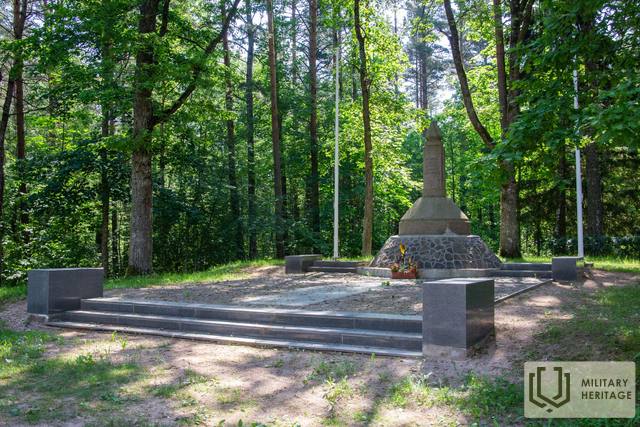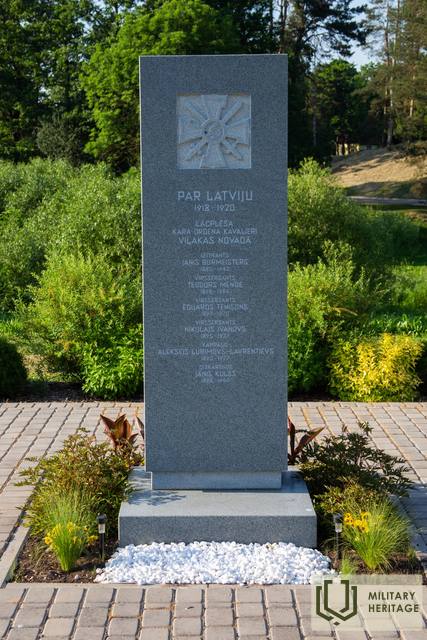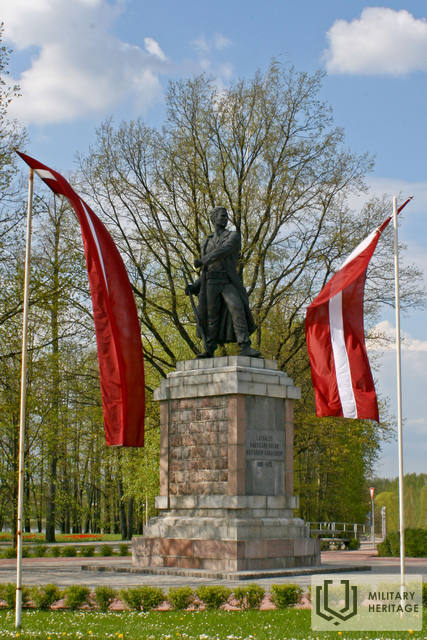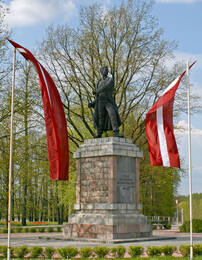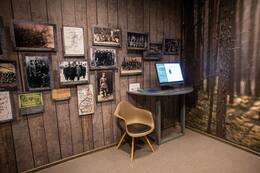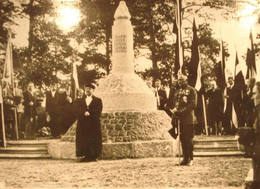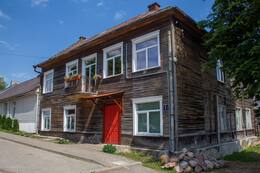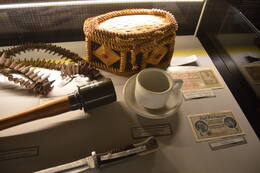Liberation of Northern Latgale from the Bolsheviks
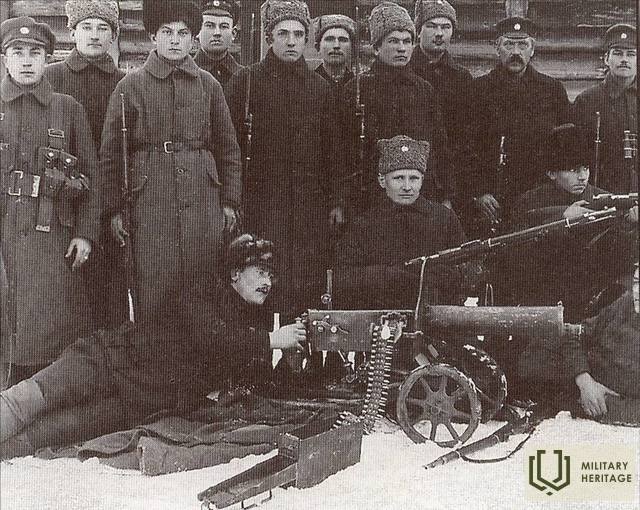
On December 1, 1918, the Red Army units, based on the Red Riflemen units, invaded the territory of Latvia. In order to protect their homes, families, native region and escape from terror, the men of the Balvi area took up arms and went into the forests, the formation of the first “green” groups began. In the spring of 1919, when mobilization was announced, many men of the Balvi area found fighting in the Soviet Latvian Army unacceptable and joined the “green” groups. The Balvi, Silakrogs, Rugāji, Teteru-Dūrupe and Liepna groups were formed. The activities of the “green” groups in the Balvi area became more active in March 1919.
In May 1919, as the Latvian Provisional Government's armed forces continued their offensive in the east, partisan activity in the Balvi area increased. By the spring of 1919, several partisan groups had formed, each group had its own commander, and there was almost no communication between the individual "green" groups.
In May - June 1919, none of the warring armies were in the Liepna - Balvi - Rugāji area, and no administrative institutions were functioning. The defense of the region was taken into their own hands by local partisans, creating a system of support points from Lake Lubāns to Liepna. The partisans had a difficult task - to hold a front line of about 50 km in length, providing posts on the main roads as much as possible. Natural obstacles were used for defense - swampy areas, forested areas.
At the beginning of June 1919, the “green” groups of Rugāji, Sudarbe, Orlova, Silakrogs, Balvi, Kuprava united into the Balvi partisan division, with Jānis Vīndedzis as its commander. The Balvi partisan division had about 100 men, with posts guarding the most important roads at Rugāji, Sudarbe, Orlova, Silakrogs, Kuprava, and communications were provided by a cavalry division of about 30 men using their own horses.
In June, the Balvi partisan unit engaged in clashes with enemy reconnaissance groups, preventing the Red Army from returning. Clashes occurred near Silakrogs, Augustova, Orlova, Sudarbe, Kuprava, Pokrot, and Tikainiai. Despite the small number of partisans, they gained an advantage in almost all battles, which was facilitated by both their familiarity with the swamps and forests and the support of the population.
In early July 1919, the Commander-in-Chief of the Eastern Front issued an order to rename the Balvi partisan unit the Latgale partisan regiment, with Lieutenant General Jānis Vīndedzis appointed as its commander. The regiment became a regular unit of the army, consisting mainly of local residents, mostly volunteers, including older men and teenagers beyond the age of conscription. At the beginning of July, the regiment had a little more than 700 soldiers, but the number of combat units gradually increased, by October there were already 3 battalions with 8 companies and about 2,000 soldiers. In parallel with the formation of the regiment, active combat activity also took place. In 1919, the fighting continued with varying success, the partisans held the territory they had occupied. The largest battles took place near Stompaki, Kokoreva, Augustova, Susāji and Liepna. In August and September, fighting continued in the regiment's sector both as reconnaissance clashes and as offensive operations.
In October, Captain Jānis Skujiņš took over the command of the regiment. The regiment expanded its territory, pushing back Red Army units, and also had to retreat, leaving behind recently liberated settlements. The regiment's composition increased as many local residents voluntarily joined the Latgale partisan regiment after the liberation of the area, and volunteers from Soviet-controlled territories also arrived, secretly crossing the front.
On January 9, 1920, at 6 a.m., an attack began simultaneously on the entire Northern Latgale front.
The regiment's main task was to capture the Pitalova railway junction, thereby preventing the enemy from moving to southern Latgale, where parts of the Lithuanian and Polish armies were attacking.
The regiment fought the largest battles near Kārsava, Baltinava, Augšpils, and Pitalova. Fierce battles took place near Šķilbēni, the 2nd battalion of the Latgale Partisan Regiment attacked the Šķilbēni Highlands, the battles continued for several days, the opponent was the Special Task Regiment of the 15th Army.
The liberation of Northern Latgale was the most serious test for the Latgale Partisan Regiment in its entire fighting history. The soldiers of the regiment, mainly local residents, made excellent use of their knowledge of the area and skillfully applied the tactics of partisan warfare.
For their heroism in battle, 53 soldiers of the regiment received the highest government award, the Lāčplēsis War Order. Their fates unfolded differently; during the Soviet regime, many were imprisoned, exiled to Siberia, or emigrated during World War II.
To honor the memory of fallen soldiers, after the War of Independence, monuments were erected and memorial sites were established in Balvi, Viļaka, Baltinava, Škilbēni, Rugāji, Tilža, Kārsava, Rītūpe, Linava parish,* Kacēni parish* (*now the territory of the Russian Federation). In many cemeteries - Bērzkalne parish. Priedaine cemetery, Rugāji parish. Cepurnieki cemetery, Garosilu cemetery, Stāmere cemetery, Balvi city Orthodox and Lutheran cemeteries, Liepna parish. cemetery, etc., people are buried who, with their heroism and selflessness in the War of Independence, contributed to the liberation of Latvia.
Materials from the Balvi County Museum collection
Related timeline
Related topics
Related objects
Monument to the fallen soldiers of the Latgale Partisan Regiment 1919 - 1920
During the Latvian War of Independence (1918-1920), the Balvi Partisan Division was formed in the Balvi region on the initiative of local residents, which was soon transformed into the Latgale Partisan Regiment.
The idea for a regimental monument arose as early as 1927. In 1933, former Latgale Partisan Regiment soldier and stonemason Jānis Pilmanis built a 5-meter-high stone pedestal for the monument at his own expense. The bronze monument itself was created by artist Kārlis Jansons.
The monument dedicated to the memory of the fallen soldiers of the regiment was unveiled on August 14, 1938, with the participation of General Jānis Balodis. Although the official name of the monument was “Guarding Partisan”, the people soon simply called the monument “Balva Stanislava”.
After Latvia was occupied by the USSR, the monument was demolished in the spring of 1941 by decision of the Abrene County Executive Committee. The high pedestal was demolished, but the bronze monument itself remained in the Balvi police yard.
During the German occupation, the monument's pedestal was not restored, but the bronze monument itself was placed in its previous location. After the second return of the Soviet occupiers in 1944, the monument was completely destroyed.
When Latvia regained its independence, the people of Balvi collected donations for the restoration of the Latgale Partisan Monument. On November 11, 1993, the restored monument by Andrejs Jansons, son of artist Kārlis Jansons, was unveiled in Balvi.
An additional commemorative plaque was added to the back of the monument's pedestal with the text "Renovated also honoring the Latgale national freedom fighters of 1940-1954."
Exhibition "North Latgale in the Freedom Struggle" at the Balvi Regional Museum
The museum is located in the territory of the Balvi Manor complex, in the building of the former manor barn. The exhibition allows you to look into the history of the Latvian War of Independence from the point of view of Northern Latgale, tracing the history of the formation and activities of the Latgale Partisan Regiment. There are photographs and copies of documents that are not available elsewhere, including the order of 5 July 1919 on the formation of the regiment. The internal orders of the regiment are unique – they were written in Russian between July and October 1919. This reflects the peculiarities of the formation and composition of the regiment as a local unit, where Latvians, Latgalians, Russians, and Jews fought together. The regiment only switched to Latvian in its internal orders after it was fully integrated into the Latvian Army system when it was supplemented by mobilised soldiers from other regions of Latvia. The exhibition also reflects the liberation operation of Northern Latgale, during which the Latgale Division of the Latvian Army liberated the surroundings of Viļaka, Jaunlatgale and Kārsava in battles that lasted from 9 to 15 January 1920. Evidence of both the operation as a whole and the combat activities of the Latgale Partisan Regiment during the liberation of Kārsava are on display in the exhibition.
Monument to the soldiers who fell in the Latvian liberation struggle in Yaškovo
Located on the left side of the Viļaka – Vientuļi road section (P35), near the Jaškova cemetery chapel.
Monument to the Latvian and Estonian soldiers who fell in the War of Independence.
The monument, created by sculptor Kārlis Zemdega in memory of the soldiers who fell in the 1920 Liberation War in Jaškovo, was first unveiled on September 22, 1935, at the Viļaka Brothers Cemetery, established in 1929.
The freedom struggle against the Red Army in the Viļaka region began with the attack of the Latvian Army and the Latgale Partisan Regiment on January 9, 1920. Estonian soldiers also participated in it. Viļaka was liberated on January 9, but the fighting to the east of it continued for several more days. Both before and after the liberation of Viļaka, the fallen soldiers were buried in various places known to the local population. As the Latvian state stabilized, people began to think about arranging a common fraternal cemetery in Viļaka. Already on November 18, 1923, after a solemn service in the Catholic church, held by Dean P. Apšinīks, a large procession went to the newly created fraternal cemetery on a hill, in the so-called Jaškovs - in the immediate vicinity of Viļaka. Soon the foundations of the monument were built, and donations for the monument began to be collected. The identification of the graves of the fallen soldiers took time, and only on November 3, 1929, the reburial in the future fraternal cemetery took place. 31 Latvian and 14 Estonian soldiers who fell in the Viļaka area were buried there. In 1935, the monument was ready and it was solemnly consecrated on September 22.
During the pre-war years of Latvian independence, all important national events in Viļaka parish were associated with the fraternal graves and this monument.
The monument was destroyed during the post-war years of Soviet rule, but its granite parts, although damaged, were preserved. The monument was restored on November 11, 1990 - Lāčplēsis Day.
Private Exhibition “Abrene Rooms”
The Private exhibition “Abrene Rooms” is located in the town of Viļaka, in a building with a diverse history. Initially, the building was located on the old Marienhausen market square, later it housed apartments, offices and various shops, and during World War II, it was the Latvian self-defence headquarters, the Gestapo and also the Cheka. Several exhibitions reveal diverse events and historical periods in the town of Viļaka and its nearest vicinity covering the time period from 1920 to 1960 when Viļaka was part of Jaunlatgale, later Abrene, district. The exhibit features items from the national partisan camp in Stompaki Swamp, which are related to the national partisan movement in the Latgale region. Documents and photos associated with the War of Independence are also on display. The latest exhibition is dedicated to the once-famous motocross track “Baltais briedis”.
Memorial stele to the Cavaliers of the Lāčplēsis War Order
Located next to the Sacred Heart of Jesus Roman Catholic Church in Viļaka.
A memorial stele for the cavaliers of the Lāčplēsis War Order in Viļaka municipality was unveiled on November 11, 2017. The fates of 28 cavaliers of the Lāčplēsis War Order are linked to the name of Viļaka municipality.
The granite stele was created as part of the project “Remember Lāčplēšis” dedicated to the centenary of the state of Latvia. In honor of the soldiers who fell in the Latvian War of Independence, memorial stele of a uniform model will be installed throughout Latvia. The initiator of the project is the Youth Guard and Information Center.
Five knights of the Lāčplēsis War Order, whose names are engraved on the memorial stele, lived in the territory of the present-day Viļaka district after the end of the War of Independence:
– Jānis Kuļšs was a young farmer in Apsīši, Šķilbēni parish,
– Aleksejs Ľubimovs (Lavrentjevs) lived on the Fortepjanova farm in Šķilbēni parish, later in Viļakas,
– Teodors Mende managed the farm assigned to him and was a forester in the village of Katleši, Žīguri parish,
– Eduards Tenisons lived at the Vecumu station, later lived in the village of Čabatrova and worked at the “Viļaka” post office,
– Jānis Burmeistars lived in Šķilbēni parish for some time after 1928.
The Brothers' Cemetery in Viļaka district is the resting place of 45 soldiers who gave their lives defending Latvia from the Bolsheviks in 1920. January 9 was the day when the attacks began in Northern Latgale, and despite the difficult weather conditions at the time, Viļaka was liberated on the same day.
During the battles for the liberation of Latgale in the Viļaka region, Estonian soldiers fought shoulder to shoulder with Latvian army soldiers and partisans against the Red Army. Many of them gave their lives for a free Latvia.
Vilaka Museum
Viļaka Museum operates in two buildings – the Catholic parish house, built in 1913, which is an important cultural heritage object of the town, and the other building of the museum – a former monastery of Capuchin monks, whose cellars are closely related to the national partisan movement in Stompaki and the Soviet Cheka. According to the memories of the locals, people were held and tortured in these cellars. The old museum building houses several exhibitions, with one of the exhibitions dedicated to the 1920 freedom battles in Northern Latgale, and the second – to the events of the Second World War – the Jewish Holocaust in Viļaka and information about the families who were shot. More information about each family is available based on their street address.
The exhibition is supplemented by information about the national partisan movement in Stompaki – various testimonies, photographs and objects. Visitors can learn about the military heritage sites in and around Viļaka, such as the Freedom Fighters Monument in Jaškova, which was demolished during the Soviet era and restored in 1990, and the stele dedicated to the recipients of the Order of Lāčplēsis. The sound of World War II aircraft is incorporated into the exhibition of the museum, as the German Luftwaffe airfield was located near Viļaka. The museum offers an opportunity to see some memories of the Second World War events in Viļaka, as well as to receive information about the German prisoner-of-war camp in Rači.





